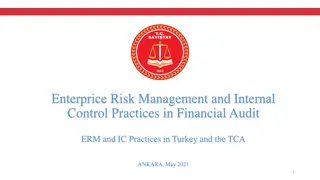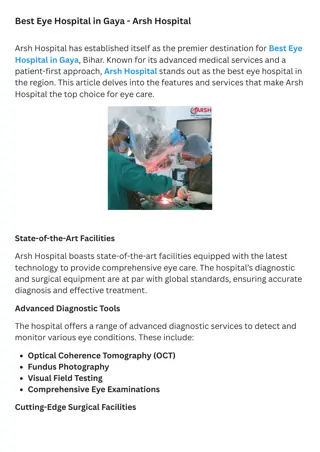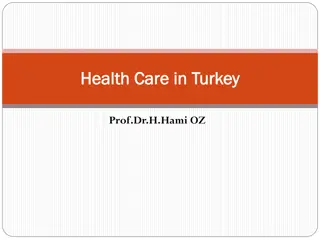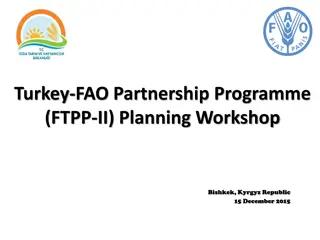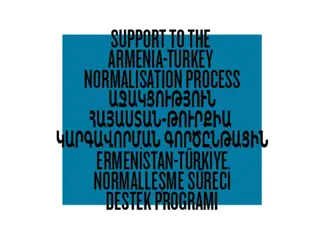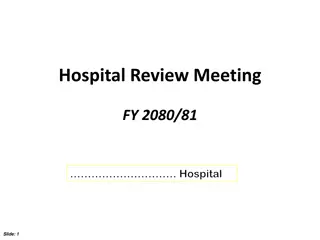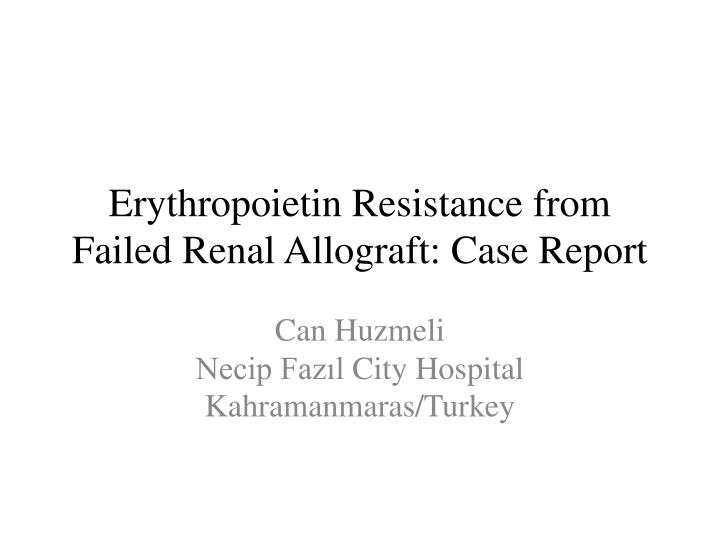
Understanding Erythropoietin Resistance in Chronic Kidney Disease
Learn about erythropoietin resistance in chronic kidney disease, its impact on anemia, and the risk factors associated with it. Explore guidelines and case reports to enhance your knowledge in managing this condition effectively.
Download Presentation

Please find below an Image/Link to download the presentation.
The content on the website is provided AS IS for your information and personal use only. It may not be sold, licensed, or shared on other websites without obtaining consent from the author. If you encounter any issues during the download, it is possible that the publisher has removed the file from their server.
You are allowed to download the files provided on this website for personal or commercial use, subject to the condition that they are used lawfully. All files are the property of their respective owners.
The content on the website is provided AS IS for your information and personal use only. It may not be sold, licensed, or shared on other websites without obtaining consent from the author.
E N D
Presentation Transcript
Erythropoietin Resistance from Failed Renal Allograft: Case Report Can Huzmeli Necip Faz l City Hospital Kahramanmaras/Turkey
Anemia is one of the most important complications of chronic kidney disease. Erythropoietin deficiency is one of the most common cause of anemia in patients with chronic kidney disease.
Erythropoietin Resistance According to the Kidney Disease Outcomes Quality Initiative Guideline erythropoietin resistance; despite regular and full dose erythropoietin treatment, it is defined as a significant decrease in hemoglobin levels or a significant increase in erythropoietin dose required to maintain a certain level of hemoglobin or a failure to reach 11 g / dL hemoglobin levels despite the administration of 500 U / kg / week epoetin or equivalent dose of erythropoietin. National Kidney Foundation. K/DOQI Clinical Practice Guidelines and Clinical Practice Recommendations for Anemia in Chronic Kidney Disease. Am J Kidney Dis 2006;47:1-145
Erythropoietin Resistance The European Best Practice Guideline defines erythropoietin resistance as requiring >20.000 IU (> 300 IU / kg) erythropoietin alpha or beta or 1.5 g / kg of darbepoetin alfa (> 100 g / week) per week. Locatelli F, et al. European Best Practice Guidelines Working G: Revised European best practice guidelines for the management of anaemia in patients with chronic renal failure. Nephrol Dial Transplant, 19(Suppl. 2):ii1 ii47, 2004
Risk Factors for Erythropoietin Resistance Absolute or functional iron deficiency Gastrointestinal blood loss Hemolysis Inflammation infection Malignancy Folic acid deficiency Alves MT et al. Resistance of dialyzed patients to erytropoietin. Rev Bras Hematol Hemoter 2015
Risk Factors for Erythropoietin Resistance Vitamin B12 deficiency, Insufficient hemodialysis Hyperparathyroidism Angiotensin converting enzyme inhibitor Angiotensin II receptor blocker Anti-erythropoietin antibody Alves MT et al. Resistance of dialyzed patients to erytropoietin. Rev Bras Hematol Hemoter 2015
Case 52 year old male In May 2005, idiopathic chronic renal disease stage 5 was included in the hemodialysis program for 3 days per week In September 2012, the kidney transplant (deceased donor) was made to the patient Hemodialysis started again in February 2015 with renal graft failure
Case He was using cyclosporin and methylprednisolone Immunosuppressive medication was discontinued 3 months after starting hemodialysis A total of 5 times replacement of erythrocyte suspension (2U each time) was made to the patient
Semptoms Fever weakness Fatigue Sensitivity in the graft region
Laboratory Before treatment After treatment 5.4 13 Hemoglobin (gr/dL) 46 50 Blood urea nitrogen mg / dL 7.8 6.5 Serum creatinine (mg/dL) 6,5 7.2 Total protein (gr / dL) 2.2 3.2 Albumin (gr / dL) > 2000 1327 Ferritin (ng/mL) 40% 30 Transferrin saturation 117 13 C-reactive protein (mg/L) 70 35 Sedimentation (mm / hour) 73% 70% URR 1.34 1.30 Kt/v
Hematuria was present in urine analysis. Renal ultrasonography was interpreted as normal. Peripheral blood smear was consistent with normocytic normochromic anemia. Bone marrow biopsy was normal. Culture of blood, urine and sputum consistently was negative. CMV IgM test was negative.
The patient was using epoetin beta 150 U / kg and vitamin D in treatment. With the diagnosis of Graft Intolerance Syndrome, 10 mg of methylprednisolone was given. Erythropoietin treatment was discontinued after 4 months of treatment with methylprednisolone on Hb 11.8 gr / dl. Methylprednisolone therapy was discontinued after 6 months . Anemia did not occur in the patient even though passed one year.
*US data suggest that patients with failed transplants constitute 4.1% of the incident dialysis population and are now the fifth commonest cause of starting dialysis in the US. * In the UK, between 2011 and 2012, 27% of those who die of kidney transplantation have experienced graft failure before dying.
Distribution of Renal transplantation patients with functioning graft according to donor source as of the end of 2015 (according to the data obtained from 18 centers Living donor 5111 Deceased donor 1404 Total 6515
Distribution of all renal transplantation patients transplanted in 2015 according to final situation as of the end of 2015 in Turkey Followed with functioning graft 3068 (%95,7) Returned to dialysis 42 (%1,31) Died 94 (%2,93) Total 3204 Living donor 2534 Returned to dialysis in living donor 28 Death in living donor 43 Deceased donor 670 Returned to dialysis in deceased donor 14 Death in deceased donor 51
Mortality for transplant failure patients on dialysis was twice as high compared with the risk for transplant-naive patients. All-cause mortality was 32% higher for transplant failure patients on dialysis than for transplant-naive patients. Mortality rates were lowest in patients with good graft function, high in waiting list, and highest in patients returning to dialysis as a result of developing graft failure. Gill JS, et al. The importance of transition between dialysis and transplantation in the case of end-stage renal disease patients. Kidney Int 2007;71:442-447 Fernandez Fresnedo G et al. Survival after dialysis initiation: a comparison of transplant patients after graft loss versus nontransplant patients. Transplant Proc 2008; 40: 2889 2890. Perl J, et al. Reduced survival and quality of life following return to dialysis after transplant failure: the Dialysis Outcomes and Practice Patterns Study. Nephrol Dial Transplant 2012; 27: 4464 4472
Anemia was associated with increased risk of mortality in patients who have lost grafts. Patients who have lost the graft and have returned to dialysis have been shown to be more anemic due to erythropoietin resistance than patients on dialysis. Solid CA, Epoetin use and kidney disease outcomes quality initiative hemoglobin targets in patients returning to dialysis with failed renal transplants. Kidney Int 2007
Continuation of immunosuppression after a failed transplant Potential beneficial effects Potential adverse effects Metabolic complications (diabetes, hypertension, dyslipidemia) Preservation of residual kidney function Decreased incidence of graft intolerance syndrome and the need for allograft nephrectomy Steroid-associated adverse effects (e.g., diabetes, cataracts, myopathy, and avascular necrosis among others) Minimization of allosensitization Cardiovascular complications Avoidance of overt acute rejection Increased susceptibility to infection Prevention of adrenal insufficiency syndrome Malignancy (especially skin cancers, Kaposi s sarcoma, non-Hodgkin s lymphoma, and lip cancers) Prevention of reactivation of systemic disease (e.g., systemic lupus erythematosus, vasculitis) Costs (particularly when data supporting continued immunosuppression are lacking) Pham PT et al. Management of patients with a failed kidney transplant: Dialysis reinitiation, immunosuppressionweaning , and transplantectomy. World Nephrol. 2015
Reasons for Withdrawal of Immunosuppression After Renal Transplant Failure Increased risk of infection Increased risk of malignancy Complications of corticosteroid therapy
Complications of Withdrawal of Immunosuppression Secondary adrenal insufficiency Loss of residual renal function Potentially adverse immunologic effects among those pursuing another transplantation Requiring transplant nephrectomy
Graft Intolerance Syndrome Low grade fever Flu-like symptoms Pain in the graft region Hematuria Tenderness and swelling of graft
Graft intolerance syndrome is commonly seen in the first year. Despite the different immunosuppressive treatment withdrawal protocols, Graft intolerance syndorome is seen in 30-50% of patients. Pham PT, Management of patients with a failed kidney transplant: Dialysis reinitiation, immunosuppression weaning, and transplantectomy. World J Nephrol 2015
Increased graft size Elevated C-reactive protein Elevated erythrocyte sedimentation rate Elevated ferritin levels Anemia resistant to erythropoietin therapy
Treatment options Non-steroidal anti-inflammatory drugs Corticosteroids Percutaneous graft embolization Transplantectomy Delgado P. Intolerante syndrome in failed renal allografts: incidence and efficacy of percutaneous embolization. Am J Kidney Dis 2005
* In the study included 33 patients having Graft intolerance syndrome. * Percutaneous embolization was performed in the treatment of these patients. * 85% of patients recovered after treatment with percutaneous embolization. * Percutaneous embolization in five (%15) patients failed and they required graft nephrectomi. * In this study, graft nephrectomy was recommended in patients who do not respond to percutaneous embolization. GONZA LEZ-SATUE C, Percutaneous embolization of the failed renal allograft in patients with graft intolerance syndrome BJU International 2000
In the study made by Al Badaai et al. Group 1 (32 patients ): patients who had percutaneous embolization as first-line treatment. Group 2 (40 patients): patients directly treated by surgical removal. To avoid pain, patients in group 1 were given IV hydrocortisone (100 mg x 4/day for 2 3 days) and analgesics. The success rate of percutaneous embolization treatment in Graft intolerans syndrome was 84.3% Nephrectomy was required in five patients. There were complications in two patients with percutaneous embolization. Complications developed in 14 patients made the nephrectomy. Al Badaai G, Renal graft intolerance syndrome in late graft failure patients: efficacy and safety of embolization as first- line treatment compared to surgical removal Transplant International 2017
Delgado et al. diagnosed Graft intoleras syndrome in 55 of 149 patients returning to dialysis. The incidence of graft intolerance syndrome was found to be 37% Vascular embolization was performed in 48 patients. 65% (31) of patients after vascular embolization were successfully treated. Percutaneous embolization was repeated in 8 patients, being successful in 6 of them. 22% (11) of patients required nephrectomy in this study. Delgado P et al. Intolerance syndrome in failed renal allografts:incidence and efficacy of percutaneous embolization. Am J Kidney Dis;2005;46:339
Krause I, Graft intolerance syndrome in children with failed kidney allografts clinical presentation, treatment options and outcome Nephrol Dial Transplant 2008. In the study, Krause et al. published the treatment of the patient (no:11) with Graft intolerance syndrome. Ten patients were treated with indomethacin (25 mg/day for 10 14 days); in two patients, the treatment was successful . In five patients high-dose prednisone (1 2 mg/kg/day) was added to indomethacin and administered for 14 days with gradual tapering-off during 1 3 months. Complete remission was achieved in one patient. Seven patients were used percutaneous embolization. Six patients were provided a remission.
Absolute and Relative Indications for Transplantectomy Absolute indications (commonly accepted) Relative indications (controversial) The presence of hematologic or biochemical markers of the chronic inflammatory state Primary nonfunction Hyperacute rejection Erythropoietin resistance anemia Early recalcitrant acute rejection Elevated ferritin level Early graft loss (generally defined as graft loss within the first year) Elevated C reactive protein Arterial or venous thrombosis Elevated erythrocyte sedimentation rate Graft intolerance syndrome Low prealbumin/albumin Recurrent urinary tract infections or sepsis/urosepsis Graft loss due to BK nephropathy and high level BK viremia Multiple retained failed transplants prior to a repeat transplant Pham et al, Management of patients with a failed kidney transplant: Dialysis reinitiation, immunosuppression weaning, and transplantectomy World J Nephrol 2015, pp 148-159 Cancer
Immunosuppressive therapy in renal graft failure in patients returning to dialysis Living donor kidney recipients; Continue low-dose immunosuppressive therapy Pham et al, Management of patients with a failed kidney transplant:Dialysis reinitiation, immunosuppression weaning, and transplantectomy World J Nephrol 2015, pp 148-159
Deceased donor kidney recipients If there is no renal residual function, immunosuppressive therapy is discontinued. If the patient has renal residual function, the risk of complications is assessed. If there is a risk of high complication, immunosuppressive therapy is discontinued. If there is no risk of high complication, low-dose immunosuppressive therapy is continued. Pham et al, Management of patients with a failed kidney transplant:Dialysis reinitiation, immunosuppression weaning, and transplantectomy World J Nephrol 2015, pp 148-159
Suggested Immunosuppression Withdrawal Protocols Based on Maintenance Therapy CNI + antimetabolitea + prednisone Discontinue antimetabolite at initiation of dialysis Taper CNI over 4-6 wk Maintain same steroid dose at initiation of dialysis 2-4 wk, then taper by 1 mg/mo (starting from 5 mg daily) until off. Pham et al, Management of patients with a failed kidney transplant:Dialysis reinitiation, immunosuppression weaning, and transplantectomy World J Nephrol 2015, pp 148-159
Suggested Immunosuppression Withdrawal Protocols Based on Maintenance Therapy CNI + mTOR inh + prednisone Discontinue mTOR inh at initiation of dialysis Taper CNI over 4-6 wk Maintain same steroid dose at initiation of dialysis 2-4 wk, then taper by 1 mg/mo (starting from 5 mg daily) until off Pham et al, Management of patients with a failed kidney transplant:Dialysis reinitiation, immunosuppression weaning, and transplantectomy World J Nephrol 2015, pp 148-159
Suggested Immunosuppression Withdrawal Protocols Based on Maintenance Therapy mTOR inh + prednisone Taper mTOR inh over 4-6 wk Maintain same steroid dose at initiation of dialysis 2-4 wk, then taper by 1 mg/mo (starting from 5 mg daily) until off. Pham et al, Management of patients with a failed kidney transplant:Dialysis reinitiation, immunosuppression weaning, and transplantectomy World J Nephrol 2015, pp 148-159
Immunosuppression Weaning Protocol Following kidney Transplant Failure and Return to Dialysis All immunosuppression apart from steroids are stopped immediately after nephrectomy. Antiproliferative agents (azathiopurine, mycophenolate) can be stopped immediately, followed by gradual taper of the CNI and mTOR inhibitor. Wean azathioprine or mycophenolate mofetil/mycophenolic acid off over 3 months; stop immediately with acute infection requiring hospitalization or IV antibiotics. Maintain prednisone 5 mg daily if plans to retransplant within 1 year of transplant failure or if residual renal function on 24-h urine provides for 0.5 mL/min urea clearance. Wean prednisone 1 mg/day per month to off if no plans to retransplant, no residual renal function or still on dialysis 6 months after kidney failure. Andrews PA, on behalf of the Standards Committee of the British Transplantation Society. Summary of the British Transplantation Society Guidelines for Management of the Failing Kidney Transplant. Transplantation 2014; 98: 1130 1133 Kassakian CT et al. Immunosupression in the failing and failed transplant kidney: optimizing outcome Nephrol Dial Transplant 2016;31:1261-1269.
Canadian authors suggested that patients returning to peritoneal dialysis may benefit from continuing some immunosuppression, to maintain residual renal function in the graft. Jassal SV, et al.Continued transplant immunosuppression may prolong survival after return to peritoneal dialysis: results of a decision analysis. Am J Kid Dis 40:178 183, 2002





